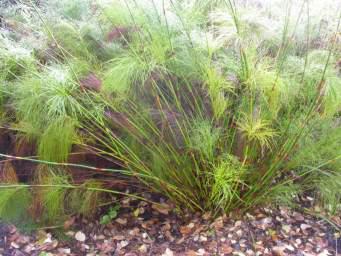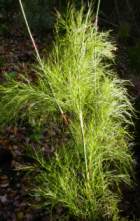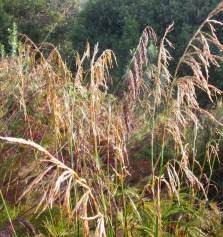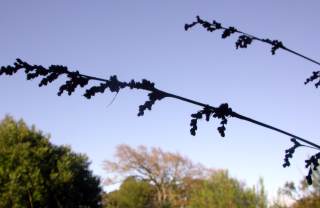Rhodocoma foliosa
Rhodocoma foliosa (N.E.Br.) H.P.Linder
Family: Restionaceae
Common names: Mikado stems, leafy rhodocoma (Eng.); kort-Langebergriet (Afr.)
Introduction
This is an unusual member of the reed family with lots of fine 'leafy' parts shoots and decorative, arching stems, suitable for planting in groups or as a feature plant.

Description
Description
At first sight this plant does not look very reed-like, as it is much branched. The plants are about 1.5 m high and about 2 m in diameter. Each stem has a large amount of finely divided, sterile branches at the nodes, which give a 'leafy' appearance, and from June to the end of January the inflorescences add a good 500 mm to the height of the plant.

The male plants have gracefully arching inflorescences, whereas the female plants have stiff, upright inflorescences. In the southern Hemisphere an attentive gardener can observe the plants produce small, greenish yellow male flowers and white female flowers during August and September. Once ripe the seed is released during December.


Within the first two years of planting the young plants produce a large amount of fresh green stems and establish a good root system. During the third year the plant reaches its full height, flowers and produces seed. In normal garden conditions the plants should reach an age of at least 10 years.
Conservation Status
Status
Least Concern (LC).
Distribution and habitat
Distribution description
This plant grows naturally in only a relatively small area in the Langeberg Mountains in the southern Cape. It is found from Swellendam in the west to Garcia's Pass in the east here it favours well-drained habitats at altitudes between 300 and 900 m, often on shale bands and gentle slopes. Although it grows on relatively cool, south-facing slopes, the plants are not exposed to frost and require the growing conditions of a Mediterranean climate with a reasonable amount of irrigation.
Derivation of name and historical aspects
History
Until fairly recently, the species of Rhodocoma were included in the large genus Restio. When Rhodocoma was resurrected by H.P. Linder in 1985, Restio foliosus was treated as a synonym of Rhodocoma gigantea. In a follow-up study by Linder in 2001, he decided that Rhodocoma gigantea should be split into two separate species based on differences in size and flowering time. Rhodocoma gigantea is taller, has bigger flowers in autumn and is killed by fire; whereas the species under discussion is smaller, more rhizotomous, flowers in spring and resprouts after fire.
The species name foliosa is derived from Latin and means leafy, or full of leaves. Rhodocoma refers to the rosy tufts of flowers of Rhodocoma capensis, the first species named in this genus.
Rhodocoma is one of the smaller genera of the family of Restionaceae, with six described species. Growth forms vary from stiff, bare stems as in R. fruticosa, to stems with clusters of many sterile branches at the nodes as in R. gigantea and R. capensis. A low-growing form of R. capensis is also an attractive plant and is available commercially.
Ecology
Ecology
As far as pollination is concerned the male and female inflorescences provide a good illustration of the efficient way the plants have adapted to fynbos areas, where windless days are very rare. Male inflorescences are grouped in drooping spikelets, which gives the flowers maximum exposure to the wind. The pollen is carried away and deposited on the female flowers, which are small but have optimal pollen-catching surfaces formed by prominent feathery styles on top of the ovary. The ovary becomes a capsule with three partitions, each with a small, brown seed. The ripe seeds are catapulted out of the capsule when it bursts open,due to the difference in surface tension that develops when the capsule is first moistened by the dew and and then dried by the fierce sunshine.
Uses
Use
Traditionally the plant was used as a broom by binding the sturdy stems with their tufts of foliage to a broomstick. The main use of the plant at present is in the horticultural industry, where it is sold commercially as a garden plant.
Growing Rhodocoma foliosa
Grow
This plant is very attractive if grown as a feature in between smaller plants; as an element of a larger border, where it can fulfil the function of a medium-sized shrub; as part of a Mediterranean or Fynbos garden, or as a plant in a container. The seed of the genus Rhodocoma reacts spectacularly to treatment with smoke or with the 'Instant Smoke Plus' seed primer. Without the treatment, the germination rate is very poor, less than 5%, whereas with the smoke treatment the germination can easily exceed 80%. It is not easy to subdivide the plants as the root system is very sensitive and does not like to be disturbed. The plants are thus best grown from seed, which is produced in large quantities by the female plants.
Like most Restionaceae this species must be grown in full sun, prefers a well-drained soil and plenty of air movement. The plants adapt to a large variety of soil types. The best time for planting restios is at the beginning of the rainy season (April-May in Western Cape), as the plants need regular watering during the first six weeks to two months after planting. After this initial period the plants can survive with a little additional watering but grow better with a normal garden-watering regime. They may be fed with standard organic fertilizers, a slow-release fertilizer or by sprinkling the surrounding soil with a small amount of ammonium sulfate during the growing season. Restios will respond to regular watering by showing more robust growth, but they are essentially plants which are adapted to a long, dry summer.
This is a fast-growing species that will be nearly 1 m high one year after sowing and will have formed a handsome plant three years after sowing. The plants have spreading rhizomes, which will spread to form a semi-tufted plant and produce new stems every year. The individual stems start to deteriorate during the third year but by that time already two new flushes of growth will have appeared for the yearly renewal of the plant. This governs the maintenance of the plant, which only needs a regular removal of the brown, dead stems.
References
- Andrews, S. & McClintock, D. 1982. Notes on Restio subverticellatus. The Plantsman 37: 230-233.
- Brown, N., Jamieson, H. & Botha, P. 1998. Grow restios. Kirstenbosch Gardening Series, National Botanical Institute, Cape Town.
- Dorrat-Haaksma, E.& Linder, H. P. 2000. Restios of the Fynbos. The Botanical Society of South Africa, Cape Town.
- Linder, H.P. 1985. Conspectus of the African species of Restionaceae. Bothalia 15: 387-503.
- Linder, H.P. 1991. A review of the southern African Restionaceae. Contributions from the Bolus Herbarium 13: 209-264
- Linder, H.P. & Vlok, J.H. 1991. The morphology, taxonomy and evolution of Rhodocoma (Restionaceae). Plant Systematics and Evolution 175: 139-160.
- Pillans, N.S. 1928. The African genera and species of Restionaceae. Transactions of the Royal Society of South Africa 16: 207-440.
- Linder, H.P. 2001. African Restionaceae. Contributions from the Bolus Herbarium 20.CD-Rom
Credits
Hanneke Jamieson
Kirstenbosch National Botanical Garden
July 2003, name updated to Rhodocoma foliosa March 2007
Plant Attributes:
Plant Type: Restio
SA Distribution: Western Cape
Soil type: Sandy, Loam
Flowering season: Spring
PH: Acid
Flower colour: Brown
Aspect: Full Sun
Gardening skill: Average
Special Features:
Horticultural zones







Rate this article
Article well written and informative
Rate this plant
Is this an interesting plant?
Login to add your Comment
Back to topNot registered yet? Click here to register.